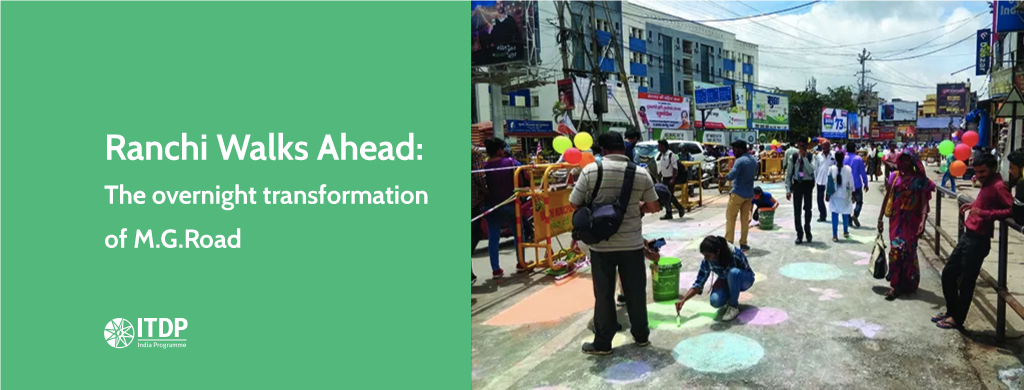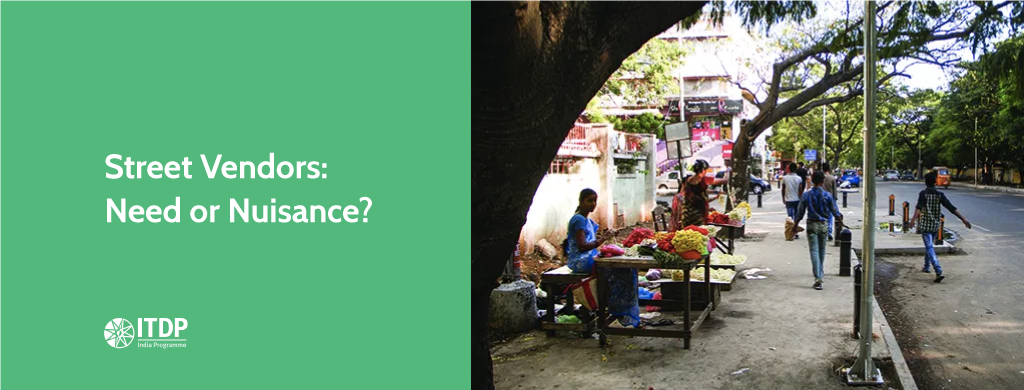One week. One week is all it took for Ranchi to see a huge change on M.G.Road, one of its busiest streets. The efforts of the Ranchi Municipal Corporation(RMC), the Ranchi Traffic Police(RTP), and ITDP India Programme brought about an incredible transformation almost overnight by a quick tactical urbanism intervention. Using simple temporary measures like paint and traffic barricades, the street space was redesigned to create colourful, dedicated walking paths for pedestrians. This simple first step has created a cascade of promising changes – a first in the state of Jharkhand.

M.G.Road, leading to the Albert Ekka Chowk is one of the busiest streets of Ranchi. Imagine a street filled with cars and two wheelers. Parked two wheelers lining both sides. E-rickshaws stopping throughout the stretch to pick up and drop off people. The shopfronts overflowing onto what’s left of the street. Somewhere in the middle of all this, despite little to no footpaths, every hour more than four thousand pedestrians try to navigate through this chaos safely. This was M.G.Road until very recently. So, what changed ?
In early August, Manoj Kumar, the Ranchi Municipal Commissioner and Sanjeev Vijaywargiya, the Deputy Mayor came together with the ITDP India Programme to identify solutions to tackle traffic congestion and lack of pedestrian space on M.G.Road. They showed great enthusiasm for a tactical urbanism intervention – a low cost, temporary change with barricades and paints to improve walking conditions on M.G.Road. The transformation aimed at creating wide dedicated walking paths on the street, clearly demarcated and painted with colourful patterns with the participation of pedestrians, in order to create a sense of public ownership of the streets. The result of this intervention would help raise awareness and a public demand for a permanent intervention. This would be the first trial of its kind for Ranchi and the entire state.

Once approved, the project moved forward rapidly with the support of the RMC and the RTP. At astonishing speed, within the next two days, all stakeholders were brought on board, a detailed study was conducted, and the designs were created. On the stretch between Sarjana Chowk and Albert Ekka Chowk, a 6 metre wide walking space was demarcated on both sides. The RMC and the RTP worked together to clear the area of all parked vehicles and mark the designated areas with barricades for a two day trial run before the final tactical urbanism intervention.
From black and white to a dash of paint
[baslider name=”Ranchi”]
The night before the inauguration, the street saw a lot of activity. Members from the RMC, RTP, and the ITDP India Programme worked with a team of painters to transform the demarcated walking area into a colourful and vibrant space. Slowly, images of white paint started to take shape on the black footpath. Outlines of children playing, a child flying a kite, and imprints of bare feet started to add life to the space. Meandering paths of paint led the way through a field of shapes of varying sizes, of bubbles and butterflies, stars and sunflowers. Hopscotch tiles for children to play, and circles to jump around. Next came the splashes of bright pink, yellow, green and blue to fill in these shapes.
Despite some rain during the painting, the teams worked on tirelessly through the night, just stopping once in a while for a cup of hot chai to warm themselves. Even late into the night, journalists and other passers-by stopped alongside the chowk, their curiosity piqued by the hustle and bustle, to find out what was happening. As a result, the project received widespread media attention, bringing many people to the chowk the next day to see the results of the nightlong efforts.
Within a few hours of hard work, the space was transformed completely. Visitors to the street in the morning were pleasantly surprised to see the results. The Deputy Mayor, the Municipal Commissioner joined a team of volunteers from the Rotaract Club of Ranchi and other institutions along with passers-by to finish painting the walking path.
The trial was a big success with the pedestrians and cyclists on the street who responded to feedback surveys with great eagerness, expressing that they felt safer and more comfortable with the new space and expressed their support for the project asking for it to be made permanent throughout M G Road.
Looking Ahead
Ranchi has already started moving in the right direction with several positive changes as a result of this intervention. The intervention has convinced the officials to replicate this approach in other parts of the city as well. The RMC has started planning a complete redesign of M.G.Road with permanent footpaths as a pilot project for the entire city. In preparation, RMC has already issued a call for bids to repair all the drainage systems along M.G.Road.

The RTP has also decided to take progressive steps to implement smart parking management on M.G.Road. Another major development is the decision of the RMC to start running city buses on the main road from early September. The department will begin working on a detailed bus operations plan for this stretch along with new infrastructure for buses.
The quick tactical urbanism intervention that happened over one week has acted as a catalyst for all these changes. These quick, low-cost and scalable initiatives can lead to a process of creating wide reaching changes across the city. This can create a city wide network of streets that enable safe walking and better transit for all.
Ranchi is already on its way!
Written by Keshav Suryanarayanan
Edited by Kashmira Dubash







